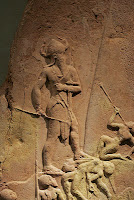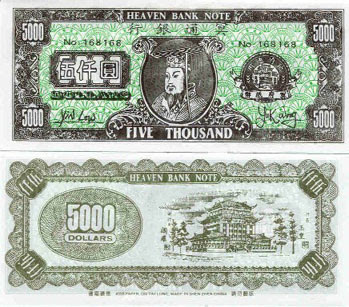Derveni and Hipponions...
Hesiod has little to say about Persephone in his poem, The Theogony..
Only that...
Zeus and Demeter are parents of :
"White armed Persephone whom Aidoneus stole".Demeter's wealth, her gift to human-kind is the grain store filled to the brim.
Hesiod explains it this way:
"Demeter gave birth to wealth, after lying with Iasius in a thrice-ploughed field."
"Demeter, bright goddess, was joined in sweet love with the hero Iasion in a thrice-ploughed fallow in the rich land of Crete, and bare Plutus, a kindly god who goes everywhere over land and the sea's wide back, and him who finds him and into whose hands he comes he makes rich, bestowing great wealth upon him".Leaving me with the distinct impression that Hesiod is describing Persephone as an aspect of Demeter under the earth, the principal essential to turn dead grain into tender green shoots.
There are Hittite themes running through this Theogony: primarily that of the children killing the father, and castration.
The Song of Kumarbi or Kingship in Heaven.A connection with feminine wheat and corn can be found in the Hittite story of Anat who finds Death (Mot) and treats him as grain:
She grabs/seizes divine/son of the El, Mot; with bladeHomer, on the other hand transmitted the myth as most of us first hear it. His is the most Mesopotamian account of Persephone in both the Odyssey, Iliad and The Homeric Hymns.
she does cleave/split him, with fan/sieve she does winnow
him, with fire she does burn him,
with hand-mill/mill-stone she grinds him, in the field
she does sow/scatter him, his remnants/pieces indeed devoured
by birds, his limbs/parts/portions indeed consumed
by fowl.
Persephone is described as dreadful, as Mistress of Justice and as Queen of the Underworld, not just a principal...she gets far more than six words from Homer!
Again, Persephone is described as the daughter of Zeus and Demeter...
And the story ends with Demeter instituting the Sacred rites of Eleusis:
Then she went, and to the kings who deal justice, Triptolemus and Diocles, the horse-driver, and to doughty Eumolpus and Celeus, leader of the people, she showed the conduct of her rites and taught them all her mysteries, to Triptolemus and Polyxeinus and Diocles also, -- awful mysteries which no one may in any way transgress or pry into or utter, for deep awe of the gods checks the voice. Happy is he among men upon earth who has seen these mysteries; but he who is uninitiate and who has no part in them, never has lot of like good things once he is dead, down in the darkness and gloom.
Homer and Hesiod can be placed neatly on a time-line...somewhere within 700 to 500 BC. Hesiod is easier to date because in Works and Days he mentions stars and planets...but just to make things simple, circa 600 BC is good enough...as a way to place the chronology of Persephone as described by Homer and Hesiod...
And then there is Derveni and Hipponions...and the subject of 'The Orphic Persephone'.
By 500 BC Persephone is no longer the abducted child, and famine and plague are not the concern; like Eleusis, the focus has become life after death, rather than civilisation. Neither Derveni or Hipponion mention Persephone directly, but both treat her as if her status and role in the Underworld is well understood.
450 BC - The Hipponion text is a totenpass, a passport into the Otherworld. It is text impressed on Gold Foil and contains a set of instructions to initiates about what to do after death:
This is sacred to Memory: when you are about to die, you will find yourself at the House of Hades; on the right there is a spring, by which stands a white cypress. Descending there, the souls of the dead seek refreshment. Do not even approach this spring; beyond you will find from the Pool of Memory cool water flowing; there are guards before it, who will ask you with cool penetration, what you seek from the shades of murky Hades. Say: “I am a son of earth and star-filled Heaven, I am dry with thirst and dying; but give me swiftly cool water flowing from the Pool of Memory.” And they will take pity on you by the will of the Queen of the Underworld, and they will give you water to drink from the Pool of Memory; and moreover, you will go on the great Sacred Way along with the other famed initiates and baccants make their way.The gold leaves are esoteric knowledge and mention a Queen of the Underworld (Persephone) and Baccants -followers of Dionysos.
They appear as possibly very expensive and certainly a much contracted form of the Egyptian guide to the underworld known as 'The Book of Gates'.
The famous line:
A kid I fell into the milkRecalls the journey of the Boat of Millions through the star strewn fields of night...the Milky Way.
350 BC - The Derveni papyrus contains accounts on how rituals were performed to please the gods. And it is almost impossible to get hold of a translation...the author has been called an Orphic, but the word Magi is now used as well.
The term Orphic isn't what it once was...!
It is also a theogonic-cosmogonic poem extending the theogony of the gods backwards to night...which used to be considered an 'Orphic' theme.
The Derveni papyrus is an ancient Greek papyrus roll that was found in 1962. It is a philosophical treatise that is an allegorical commentary on an Orphic poem, a theogony concerning the birth of the gods, produced in the circle of the philosopher Anaxagoras in the second half of the 5th century BC, making it "the most important new piece of evidence about Greek philosophy and religion to come to light since the Renaissance" (Janko 2005). It dates to around 340 BC, during the reign of Philip II of Macedon, making it Europe's oldest surviving manuscript. It was finally published in 2006.
The text is a commentary on a poem ascribed to Orpheus. Fragments of the poem are quoted. The poem begins with the words "Close the doors, you uninitiated", a famous admonition to secrecy, recounted by Plato. The theogony described in the poem has Nyx (Night) give birth to Heaven (Uranus), who becomes the first king. Cronus follows and takes the kingship from Uranus, but he is likewise succeeded by Zeus.The Derveni papyrus text stops as Zeus commits incest with his own mother...so it isn't possible to know if the text continues with what is known as Orphic theogony by telling how Zeus goes on to father Dionysos by committing incest with his daughter, Persephone....
A compilation of Late Hellanistic Orphic texts known as Rhapsodies...
Begin with a theogony to outdo Hesiod and the Enuma Elish
To Musaios: These things keep in thy mind, dear son, and in thy heart, well knowing all the things of long ago, even from Phanes. Lord, son of Leto, far shooter, mighty Phoibos, all seeing, ruler over mortals and Immortals, Helios, borne aloft on golden wings, this is now the twelfth voice of those I heard from thee. ‘Twas thou that said it, and thee thyself, far shooter, would I make my witness.
These they call Giants by name among the Blessed Gods, for that they were born from Earth (Ge) and from the blood of Heaven (Ouranos). Of this Chronos, the Ageless One, whose counsels never perish, was born Aither and a great yawning gulf on this side and on that: and there was no limit to it, no bottom nor foundation.(All things were in confusion) Throughout the misty darkness.Then great Chronos fashioned in the divine Aither a silvery egg.And it moved without slackening in a vast circle. And it began to move in a wondrous circle.And at the birth of Phanes the misty gulf below and the windless Aither were rent.First-born, Phaethon, son of lofty (beauteous) Aither. Whom they call Phanes…because he first appeared in the Aither. With four eyes looking this way and that.With golden wings moving this way and that.Uttering the voice of a bull and of a glaring lion. Female and Father the mighty God Erikepaios. Cherishing in his heart swift and sightless Eros. The key of Mind.(of Eros-Metis) A great Daemon ever treading on their tracks. An awful Daemon, Metis, bearing the honored seed of the Gods, whom the Blessed on tall Olympos were wont to call Phanes, the Firstborn....
When the sky above was not named,
And the earth beneath did not yet bear a name,
And the primeval Apsû, who begat them,
And chaos, Tiamat, the mother of them both,
Their waters were mingled together,
And no field was formed, no marsh was to be seen;
When of the gods none had been called into being.
Enuma Elish.
Marduk, the hero of the Enuma Elish is described as having four large eyes and four big ears. Fire blazes from his mouth.
In the Orphic cosmology, Phanes …could be his brother: 'With four eyes looking this way and that. With golden wings moving this way and that. Uttering the voice of a bull and of a glaring lion'.
Continuing in best Game of Thrones tradition, the Orphic Genesis describes Titans and castration, incest, snakes and the horror of the death of a god, Dionysos son of Persephone, torn by the Titans and blasted by Zeus's thunderbolt.
Guthrie seems to think that the Orphic theogonic mythology pre-dates Homer...Well the Eneuma Elish and the religion of the dying god Osiris certainly pre-date 600 BC....


